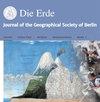Climatic turn in migration studies? Geographical perspectives on the relationship between climate and migration
IF 0.6
4区 地球科学
Q3 GEOGRAPHY
引用次数: 5
Abstract
Looking at the rapidly growing stock of literature linking climate change and migration, one could find evidence that there seems to be a “climatic turn” (Neverla 2007) concerning the explanation of migration. Climate change and its relevance for migration has undoubtedly developed into a strong argument, be it in migration research or in climate impact studies. Interestingly, already in the 19th century, scholars like Friedrich Ratzel and Ernest George Ravenstein considered ‘climate’ or ‘environment’ as relevant factors for triggering human mobility, although generally subordinated to other factors (Piguet 2013: 149). These assumed drivers of migration have been neglected for most of the last century. However, since Essam El-Hinnawi (1985) published an influential report for the United Nations Environmental Programme in which he coined the term ‘environmental refugee’, the idea that natural environments can force people to move, is back on the agenda. Ever since, we have witnessed a dynamic interand transdisciplinary field of research on the relation of climate and migration. In this field, environmental and climate scientists as well as scholars from social sciences and humanities participate. From the very beginning, geo graphers were engaged in this endeavour, too. This is hardly surprising as it is the main goal of geography to bridge the gap between human and physical sciences; therefore geographers seem predestined to contribute to the debate. Certainly, the geographical contribution is just as diverse as the interdisciplinary field itself. It differs in scope and scale, but also in perspective and epistemological position.移民研究中的气候变化?气候与移民关系的地理视角
看看快速增长的将气候变化和移民联系在一起的文献,人们可以找到证据表明,似乎有一个关于移民解释的“气候转向”(Neverla 2007)。无论是在移民研究还是在气候影响研究中,气候变化及其与移民的相关性无疑已发展成为一个强有力的论点。有趣的是,早在19世纪,弗里德里希·拉策尔(Friedrich Ratzel)和欧内斯特·乔治·拉文斯坦(Ernest George Ravenstein)等学者就认为“气候”或“环境”是引发人类流动性的相关因素,尽管它们通常属于其他因素(Piguet 2013: 149)。在上个世纪的大部分时间里,这些假定的移民驱动因素一直被忽视。然而,自从Essam El-Hinnawi(1985)为联合国环境规划署发表了一份有影响力的报告,他在报告中创造了“环境难民”一词,自然环境可以迫使人们迁移的观点又回到了议程上。从那时起,我们目睹了气候与移民关系的跨学科研究领域的动态发展。在这一领域,环境和气候科学家以及社会科学和人文学科的学者参与其中。从一开始,地理学家们也参与了这项工作。这并不奇怪,因为地理学的主要目标是弥合人文科学与自然科学之间的差距;因此,地理学家似乎注定要参与这场辩论。当然,地理上的贡献就像跨学科领域本身一样多样化。它不仅在范围和尺度上有所不同,而且在观点和认识论立场上也有所不同。
本文章由计算机程序翻译,如有差异,请以英文原文为准。
求助全文
约1分钟内获得全文
求助全文
来源期刊

Erde
GEOGRAPHY, PHYSICAL-GEOSCIENCES, MULTIDISCIPLINARY
CiteScore
2.90
自引率
6.20%
发文量
0
审稿时长
>12 weeks
期刊介绍:
DIE ERDE is a publication of the Geographical Society of Berlin
DIE ERDE is a scientific journal in Geography, with four issues per year with about 100 pages each. It covers all aspects of geographical research, focusing on both earth system studies and regional contributions.
DIE ERDE invites contributions from any subfield of both Physical and Human Geography as well as from neighbouring disciplines.
 求助内容:
求助内容: 应助结果提醒方式:
应助结果提醒方式:


